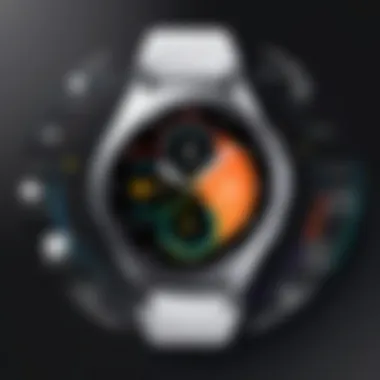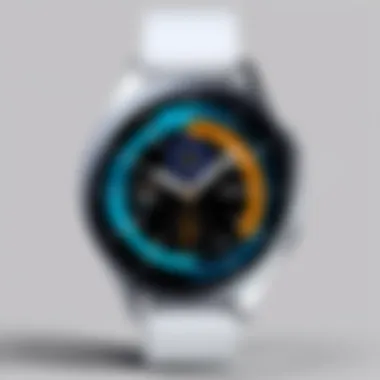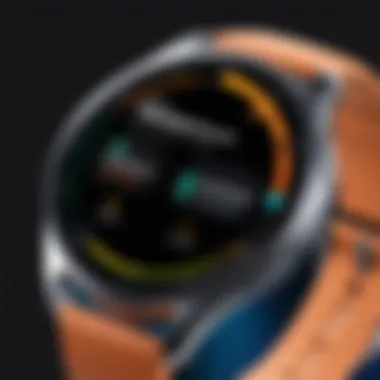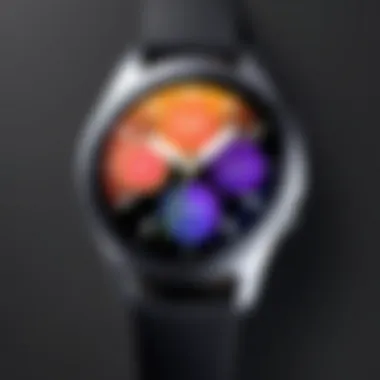In-Depth Review of the Samsung Galaxy Watch 4 Features


Intro
In the realm of wearable technology, the Samsung Galaxy Watch 4 stands out as a significant innovation. It combines functionality with style, appealing to a broad audience. As smartwatches evolve, they play a crucial role in health monitoring and lifestyle tracking, making it essential for consumers to understand their options. This article aims to provide a thorough analysis of the Galaxy Watch 4, exploring its features, specifications, and performance metrics.
Technical Specifications
Detailed Product Specs
The Samsung Galaxy Watch 4 boasts an impressive array of technical specifications that contribute to its functionality and appeal. The watch is available in various sizes, accommodating different wrist sizes and preferences. It features a vibrant AMOLED display that enhances visibility and color accuracy, even in bright sunlight. The device is powered by the Exynos W920 processor, which ensures smooth performance across applications.
Some key specifications include:
- Display: 1.2 or 1.4 inches AMOLED
- Resolution: 396 x 396 pixels (1.2 inches) or 450 x 450 pixels (1.4 inches)
- Battery Life: 40 hours with typical usage
- Operating System: Wear OS powered by Samsung
Performance Metrics
The performance metrics of the Galaxy Watch 4 demonstrate its capabilities in handling daily tasks and fitness applications. It runs smoothly due to its efficient processor and ample RAM. Users report quick response rates when navigating menus and launching apps.
Compatibility Information
Compatibility is a critical aspect for consumers. The Galaxy Watch 4 is designed to work seamlessly with Android devices, particularly those from Samsung. However, it also provides functionality with other Android models, albeit with some limitations. Users with iOS devices may encounter reduced features, as full compatibility is not available.
Product Comparisons
Feature Comparisons
When comparing the Galaxy Watch 4 to its competitors, its health tracking capabilities are notable. It includes features such as body composition analysis, ECG monitoring, and sleep tracking. These functionalities often surpass those found in similar devices from other brands.
Price Breakdown
The pricing of the Galaxy Watch 4 varies based on its specifications. Generally, it occupies a mid-range price segment, making it accessible for a wide audience. The price reflects its advanced features and quality materials.
User Experience Breakdown
User experience plays a significant role in smartwatch selection. The Galaxy Watch 4's interface is intuitive, with customizable watch faces and widgets that enhance usability. Feedback from users indicates satisfaction with its performance and aesthetic appeal. However, a few have reported issues with battery longevity under heavy usage conditions.
Practical Applications
Use Cases for Different Users
The Galaxy Watch 4 caters to a diverse group of users. Fitness enthusiasts benefit from its comprehensive health tracking features, while casual users appreciate its smart notifications and sleek design. This adaptability makes it a suitable choice for both athletes and everyday consumers.
Recommended Configurations
For optimal performance, users are encouraged to set up the watch to prioritize health tracking and notifications. Configurations can enhance the device's abilities to fit individual lifestyles and needs.
Multi-Platform Performances
The Galaxy Watch 4's performance is impressive across various platforms. Users can sync their data with popular fitness apps and services, expanding its usability and functionality.
Latest Trends
Industry Developments
The smartwatch industry is in constant evolution. New features and technologies emerge frequently, pushing boundaries and expectations. Companies continually innovate, making it essential to stay informed about new developments.
Emerging Technologies
As artificial intelligence and machine learning become more embedded in technology, smartwatches like the Galaxy Watch 4 are likely to adopt more advanced performance and health tracking capabilities. Such innovations will elevate user experiences and broaden the scope of what wearables can do.
Future Predictions


The proliferation of wearables suggests that smartwatches will become even more integral to daily life. Predictions indicate advancements in battery life, health monitoring precision, and overall connectivity in the coming years.
Buying Guides
Recommended Products
In addition to the Galaxy Watch 4, consumers may consider alternatives such as the Apple Watch Series 7 or the Garmin Venu 2, depending on their specific needs and preferences.
Purchasing Tips
When purchasing the Galaxy Watch 4, consider the size, color, and connectivity options that best suit your lifestyle. Establishing a budget will also assist in making the right choice.
Warranty and Support Information
Samsung offers a standard warranty for the Galaxy Watch 4, covering manufacturing defects and providing peace of mind for buyers. Additionally, Samsung's support channels are accessible to assist users with any inquiries or issues.
Overall, the Samsung Galaxy Watch 4 represents a pivotal point in smartwatch evolution, merging cutting-edge technology with practical applications for everyday consumers.
Preamble to Samsung Galaxy Watch
In the realm of smartwatches, the Samsung Galaxy Watch 4 stands as a significant advancement in wearable technology. This section will cover how this device functions within both the smartwatch market and individual user experiences. The importance of discussing the Galaxy Watch 4 lies in its blend of health monitoring features, user-friendly interface, and stylish design, which cater to a wide range of consumers.
Overview of the Smartwatch Market
The smartwatch market has grown rapidly in recent years, driven by advancements in technology and changing consumer habits. According to the statistics, users now prioritize features such as health tracking, calling capabilities, and connectivity with smartphones. This market evolution reflects a growing emphasis on integrating technology into daily life, particularly for health and fitness.
With numerous brands competing for user attention, each device is designed to cater to specific needs. For instance, some smartwatches focus primarily on fitness tracking, while others emphasize style and customizable options. The Samsung Galaxy Watch 4 occupies a strategic position here, attempting to balance these elements effectively.
Positioning of Samsung Galaxy Watch
Samsung's approach with the Galaxy Watch 4 aims to meet consumer demand for a multifunctional smartwatch. It combines advanced health features, such as body composition analysis and improved sleep tracking, with the aesthetics necessary for everyday wear. The watch runs on the new Wear OS, developed in collaboration with Google, which enhances app support significantly.
Unlike its predecessors, the Galaxy Watch 4 offers options in size and design, making it appealing to a broader audience. Its accessibility in terms of pricing, particularly compared to premium competitors like the Apple Watch Series, adds to its attractiveness in a crowded field. This positioning allows consumers to decide based on features and preferences rather than budget constraints alone.
"The Samsung Galaxy Watch 4 exemplifies the intersection of health and technology, providing users with tools that enhance their understanding of wellness while remaining stylish."
Key Features Overview
The Samsung Galaxy Watch 4 stands out in the smartwatch arena due to its blend of technology and functionality. Understanding the key features is imperative for anyone considering this device. This section breaks down significant aspects of the watch, such as the design, software, and health-oriented functionalities, which ultimately shape user experience.
Design and Build Quality
Materials Used
The materials used in the Samsung Galaxy Watch 4 contribute significantly to its overall durability and aesthetic appearance. The watch is crafted from premium aluminum or stainless steel, which adds a touch of elegance while ensuring longevity. The Gorilla Glass Victus protects the screen, making it less prone to scratches and wear. This robustness makes it a popular choice among users who prefer both style and resilience.
A unique feature of the materials used is the lightweight construction that circumvents bulkiness. However, while these materials are high-quality, they may not be as impact-resistant as higher-end materials like sapphire crystal. In some cases, this could lead to users needing to exercise caution in extreme conditions.
Size Options and Comfort
The Galaxy Watch 4 offers various size options, thus catering to diverse wrist sizes. The availability of 40mm and 44mm variations allows potential owners to choose according to their preference. This adaptability is essential in a marketplace that increasingly values personalization.
One of the key characteristics of this range is the comfortable fit it provides. The ergonomic design hugs the wrist, ensuring that users can wear it for extended periods without discomfort. Yet, the preference for size can vary among users, making it essential to try on the watch before making a purchase. Some wearers might find the larger variant a bit cumbersome.
Display Quality
Display quality plays a crucial role in a smartwatch’s usability. The Samsung Galaxy Watch 4 features a vibrant AMOLED display, known for rich colors and deep blacks, which enhances readability, even in bright sunlight. This characteristic is beneficial for users who engage with their notifications and apps frequently.
Additionally, the Always-On Display option allows users to glance at the time or notifications without needing to activate the screen. While this feature is attractive, it can lead to increased battery consumption, a factor that potential buyers should consider.
Software and User Interface
Operating System


The Galaxy Watch 4 utilizes Wear OS powered by Samsung, representing an important shift in the smartwatch operating systems landscape. This OS merges Samsung's user-friendly experience with Google’s application architecture, unlocking a vast range of functionalities. This collaborative software is a significant advantage as it allows seamless integration with Android devices.
This innovative OS provides a smooth experience for users, though it may take some getting used to for individuals familiar with earlier versions of Tizen. Overall, this shift to a more robust, versatile operating system adds substantial value to the Galaxy Watch 4.
App Ecosystem
A primary advantage of the Galaxy Watch 4 is its extensive app ecosystem. Users can access a variety of applications that enhance the smartwatch’s utility. Popular apps like Spotify, Strava, and Google Maps are readily available, making the watch adaptable to different lifestyles and preferences.
The integration with Google Play enhances this characteristic, allowing more users to find useful applications suited to their daily needs. However, users should note that some applications may require optimized experiences to function smoothly, occasionally causing frustration during initial setups or updates.
Customization Options
Customization options are vital for personal expression within the smartwatch domain. The Galaxy Watch 4 allows users to modify watch faces and widgets, ensuring that the device feels personalized. Users can choose from a broad selection of designs or even create their own themes.
The easy customization of these elements enhances user engagement and satisfaction. However, some users may desire deeper customization options that extend beyond the available interface. Those seeking that level of personalization may find the existing options limiting in specific contexts.
Health and Fitness Tracking
Health and fitness tracking is a core aspect of the Samsung Galaxy Watch 4. This smartwatch appeals to a broad audience, from those seeking leisurely activity monitoring to serious fitness enthusiasts. Health tracking capabilities address key personal health concerns. Users can gain insights into their heart rate, sleep patterns, and overall activity levels. This functionality not only encourages users to lead a more active lifestyle but also facilitates better health monitoring.
Heart Rate Monitoring
Heart rate monitoring is an essential feature of modern smartwatches. The Galaxy Watch 4 offers continuous heart rate tracking. This allows users to monitor their heart health throughout the day. It provides real-time insights that can alert users to irregularities. Moreover, this feature is essential for those who engage in intensive workouts. Understanding heart rate zones helps in optimizing performance during training. The accuracy of this monitoring has received positive feedback, making it a reliable tool for fitness tracking.
Sleep and Stress Management
Another significant aspect of the Galaxy Watch 4 is its ability to track sleep and manage stress levels. The smartwatch utilizes advanced sensors to analyze sleep stages. This data includes REM, light, and deep sleep insights. By understanding sleep patterns, users can make adjustments to improve their rest. Additionally, the watch provides stress management features. It employs guided breathing exercises and other methods to promote relaxation. Monitoring these aspects is vital for overall well-being.
Activity Tracking Capabilities
Workout Modes
Workout modes on the Galaxy Watch 4 offer tailored tracking for various activities. This customization is a key characteristic, allowing users to select the type of workout. Each mode optimizes performance tracking to provide accurate feedback. For example, running, cycling, or swimming modes specifically address the unique metrics for those exercises. Furthermore, many users appreciate the variety of options available. It provides motivation to explore new physical activities.
The unique feature here is the comprehensive data analysis. After workouts, users receive detailed reports. This includes heart rate data, calories burned, and workout duration, among other metrics. Such information assists users in setting and achieving fitness goals.
GPS Functionality
GPS functionality is another vital feature in the Galaxy Watch 4. It enables users to track their location accurately during outdoor activities. This is particularly beneficial for runners and cyclists who prefer to navigate without their smartphones. The integration of GPS ensures precise distance measurement, contributing to effective workout tracking.
The standout aspect of GPS functionality is the independence it provides. Users can leave their phones behind and still record detailed activity logs. However, it should be noted that prolonged use may impact battery life. This consideration is essential for users planning long workouts or extended outdoor sessions.
In summary, the health and fitness tracking capabilities of the Samsung Galaxy Watch 4 are among its strongest features. They provide valuable insights that promote better health and fitness outcomes.
Performance and Battery Life
Performance and battery life are critical aspects of any smartwatch, including the Samsung Galaxy Watch 4. These factors directly impact the user experience and define how well the device meets daily needs. In a world where instant connectivity and seamless functionality are prized, understanding how the Galaxy Watch 4 performs and lasts between charges is essential for making an informed purchasing decision.
Processor and Speed Assessment
At the heart of the Samsung Galaxy Watch 4 lies the Exynos W920 processor. This chip is optimised to deliver powerful performance while maintaining energy efficiency. With a dual-core setup, the processor can handle multiple tasks simultaneously without lag, which is vital for users who rely on various apps and functionalities throughout the day.
The speed assessment of this smartwatch indicates that loading times for apps and features are notably quick. Users will find that navigating through the operating system feels smooth and responsive. In practical terms, whether launching a fitness tracking app or responding to notifications, the Exynos W920 ensures a seamless experience, alleviating frustration often encountered with slower devices.
Moreover, this processor supports advanced functions, including smooth animations and quick transitions between different modes. The increased processing power also enhances gaming experiences for those who wish to utilize the Galaxy Watch 4 for casual gaming. In short, the combination of speed and efficiency in the Samsung Galaxy Watch 4 positions it as a strong contender in the smartwatch market.
Battery Specifications and Endurance
The battery specifications of the Samsung Galaxy Watch 4 reflect thoughtful engineering. With a capacity of 361 mAh, users can expect impressive endurance. The average battery life is around 40 hours, depending on usage patterns and settings. This means that many users can enjoy the watch throughout the day without the need for frequent recharges.
Samsung has integrated various features to enhance battery life, including power-saving modes and adjustable screen brightness settings. Users have reported that with moderate use and some settings optimised, the watch can last slightly longer than the average, making it suitable for extended outings or activities.


It's noteworthy that the charging process is equally convenient. The Galaxy Watch 4 employs a wireless charging mechanism, allowing users to quickly recharge the device when needed. This functionality means that during a short break or while getting ready for the day, users can regain significant battery life without the inconvenience of cables.
"Performance and battery life are vital elements that can not be overlooked when considering a smartwatch for daily use."
Compatibility and Connectivity
The Samsung Galaxy Watch 4's compatibility and connectivity features are crucial in determining its utility in a tech-driven era. This area enhances the user experience, ensuring seamless integration with other devices. Having a smartwatch that connects effectively opens pathways for its functionality. This section explores how well the Galaxy Watch 4 pairs with smartphones and dives into its connectivity options, which empower users in various scenarios.
Pairing with Smartphones
The Galaxy Watch 4 offers compatibility with both Android and iOS devices, although with certain limitations. To maximize its features, it pairs best with smartphones running at least Android 6.0 and Samsung's Galaxy Wearable app. This pairing process is straightforward. Users simply enable Bluetooth on their phones, download the relevant app, and follow on-screen instructions. Such ease of use is essential for those who might not be tech-savvy.
Once paired, the watch provides notifications, calls, and messages directly on the wrist. This integration is particularly beneficial for active individuals or professionals who rely on quick access to information without needing to check their phones constantly.
It is important to mention that iOS users have limited functionality compared to Android users. Features like replying to messages are typically restricted on iPhones. Therefore, while the smartwatch can connect to diverse phone brands, those using Samsung devices enjoy a more comprehensive experience.
Bluetooth, Wi-Fi, and LTE Options
The Galaxy Watch 4 includes multiple connectivity options, enhancing its versatility. The watch supports Bluetooth 5.0, which offers improved range and speed, ensuring stable connections with smartphones. This feature allows users to stay connected even when their phone is not in close proximity.
On another note, Wi-Fi support enables users to connect to a wireless network without relying on their phones. This is particularly useful in scenarios where the phone may not be available, such as during a workout or when leaving it at home.
For those who prefer more independence, the LTE version of the Galaxy Watch 4 allows for cellular connectivity. This means users can make calls, send texts, and stream music without needing a paired smartphone. The convenience of being untethered appeals to those who lead a mobile lifestyle or want a lightweight option for activities like running.
The Samsung Galaxy Watch 4's strong compatibilty with various devices, combined with its diverse connectivity options, positions it as a frontrunner in the smartwatch market.
Market Alternatives
Analyzing the Samsung Galaxy Watch 4 necessitates a broader understanding of the smartwatch market. The existence of market alternatives serves as a benchmark for determining the strengths and weaknesses of any device. Notably, the Galaxy Watch 4 finds itself positioned among competition from established brands like Apple and Fitbit. Each of these alternatives offers unique functionalities that can influence a consumer's decision.
Considering alternatives is essential for a number of reasons. Firstly, it allows potential buyers to compare specifications, design, and pricing. Secondly, understanding competitors helps in identifying gaps or strengths in the Galaxy Watch 4. Lastly, knowledge about rival products cultivates a sense of informed choice, leading to better consumer satisfaction.
Comparison with Other Smartwatches
Apple Watch Series
The Apple Watch Series is often noted for its seamless integration with the Apple ecosystem. One key characteristic of the Apple Watch is its robust app ecosystem, which is far more expansive than what Galaxy Watch 4 currently offers. Users experience a unified flow across devices, which is especially beneficial for iPhone users.
A unique feature of the Apple Watch Series is its robust health monitoring capabilities, in particular the ECG app, which has been validated in various clinical trials. This accuracy in heart monitoring has made it a popular choice among health-conscious consumers.
However, one disadvantage is that it generally requires an iPhone for optimal functionality, which limits its market reach.
Fitbit Devices
Fitbit devices prioritize health tracking, making them favorable in the fitness community. Their key characteristic is the focus on health and fitness metrics. Fitbit’s user interface is intuitive, appealing to a broader audience who may be less tech-savvy.
One unique feature of Fitbit devices includes Fitbit Premium, a subscription service offering personalized insights and health coaching. This feature enhances the user experience by providing tailored advice based on health data. However, a potential drawback is that advanced features often require the Premium subscription, making the overall cost higher for users wanting the complete experience.
Pricing Strategy
When evaluating the Galaxy Watch 4 against its competitors, pricing plays a critical role. Samsung's pricing strategy often aims to undercut rivals while offering comparable features. Understanding the price positioning relative to the Apple Watch Series and Fitbit can help consumers determine what value each option presents.
Finale
In this section, we will summarize the critical insights regarding the Samsung Galaxy Watch 4, underscoring both its strengths and weaknesses. This smartwatch emerges as a formidable choice for various users, from fitness enthusiasts to tech-savvy consumers.
Final Assessment of the Galaxy Watch
The Samsung Galaxy Watch 4 stands out in a crowded market. Its design is both striking and functional, allowing for ease of wear in daily situations. The integration of advanced health features, including heart rate monitoring and sleep tracking, provides users with substantial insights into their wellbeing. It incorporates the latest technology, which improves its functionality and user interface.
However, it is not without its shortcomings. The battery life, while acceptable, may not meet the expectations of heavy users. One must also consider the limited app selection compared to competitors, especially those in the Apple ecosystem. Ultimately, the Galaxy Watch 4 is an exemplary piece of technology that balances style with performance; it is a strong contender, but potential buyers should weigh its pros and cons.
Future Prospects in Smartwatch Technology
The future of smartwatch technology appears bright and evolving. As consumer demand grows for smarter devices, we can expect several trends to shape advancements in this realm. First, integration of health technologies will deepen. With the rising emphasis on personal health, features like advanced biometrics and stress management will likely become standard.
Moreover, interoperability across devices will also improve. As ecosystems evolve, smartwatches will be expected to work seamlessly with other devices like smartphones and home tech. This kind of connectivity is crucial for creating a smooth user experience. The integration of artificial intelligence into smartwatch technology will usher in more personalized experiences, adapting to users' habits and suggestions.
As the boundaries of technology expand, smartwatches like the Galaxy Watch 4 will undoubtedly adapt, refining their capabilities and user engagement.







